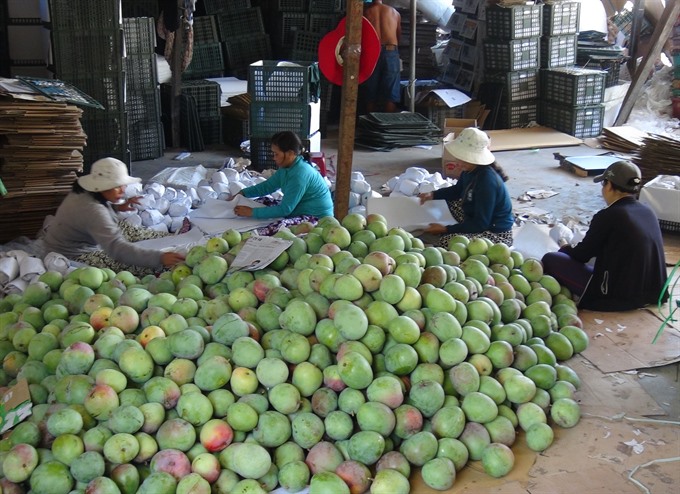 Economy
Economy

Việt
 |
| Mangos are classified at Cam Lâm district in the southern province of Khánh Hòa. — VNA/VNS Photo Phan Sáu |
HÀ NỘI — Việt
Director of the General Statistics Office (GSO) Nguyễn Bích Lâm announced information at a press conference in Hà Nội on Wednesday to report on the socio-economic indexes in 2017.The country’s quarterly GDP growth figures were 5.15 per cent in Q1, 6.28 per cent in Q2, 7.46 per cent in Q3, and 7.65 per cent in Q4.
The agro-forestry-fisheries sector, industry, construction and services sectors were the main contributors to the cumulative GDP growth rate.
The agro-forestry-fishery sector is expected to increase by 2.9 per cent, contributing 0.4 percentage points to the 6.81 per cent GDP growth. The industrial and construction sector posted an 8 per cent growth rate, contributing 2.77 percentage points whilst the service industry climbed by 7.44 per cent, contributing 2.87 percentage points.
Lâm said the economic results were achieved thanks to concerted efforts by the government, ministries and sectors, adding that Việt Nam’s socio-economic affairs this year were boosted by the steady recovery and growth of major economies such as
Global trade activities also witnessed improvements. In September 2017, the World Trade Organisation (WTO) increased its annual forecast for global trade to 3.6 per cent, higher than the previous level of 2.4 per cent and much higher than the growth of 1.3 per cent in 2016. “These are active factors for domestic production since Việt
Việt
According to the GSO, the economy in 2017 was worth VNĐ5 quadrillion (US$223 billion) and the average GDP per capita is estimated at VNĐ53.5 million ($2,385), up $170 compared to the 2016 rate.
Exports of goods and services increased by 16.74 per cent while imports of goods and services rose by 17.5 per cent.
On the business front, the registration of 126,859 new enterprises with a total capital of nearly VNĐ1.3 quadrillion marked a year-on-year increase of 15.2 per cent in number and 45.4 per cent in capital. In addition, nearly 26,448 businesses resumed operations, a year-on-year decrease of 0.9 per cent.
Inflation under control
Vũ Thị Thu Thủy, Director of the Price Statistics Department, said inflation was below the target of 4 per cent set by the National Assembly.
The consumer price index (CPI) in December rose by 0.21 per cent from the previous month and by 2.6 per cent over the corresponding time last year. The average CPI this year was up 3.53 per cent compared with the same period of 2016.
Some other commodities with increases of below one per cent were housing and construction materials (0.22 per cent), culture, entertainment and tourism services (0.03 per cent) and beverage and tobacco (0.17 per cent).
Two groups seeing decreases included food and restaurant services and post and telecommunications, down 0.08 per cent and 0.04 per cent respectively.
The reasons for the increase, Thủy said, were a hike in medical and tuition fees and an indirect consequence of a minimum wage hike that led to higher costs for family-related services.
The CPI increase was also attributed to rising prices of beverages, cigarettes and clothes ahead of the Lunar New Year festival due to rising demand. Cooking gas prices were adjusted to increase 15.91 per cent year-on-year, following the rising world gas price.
In addition, global oil prices in 2017 increased sharply, with Brent crude traded at $54.49 per barrel on average, much higher than last year’s price of $45.13 per barrel.
As of December 10, the domestic petrol price had been adjusted 18 times—10 up and eight down—leading to a hike of VNĐ1,040 per litre in petrol prices. Meanwhile, the prices of diesel increased by VNĐ1,260 per litre, making the average petrol prices in 2017 increase by 15.49 per cent against 2016, Thủy said. — VNS








